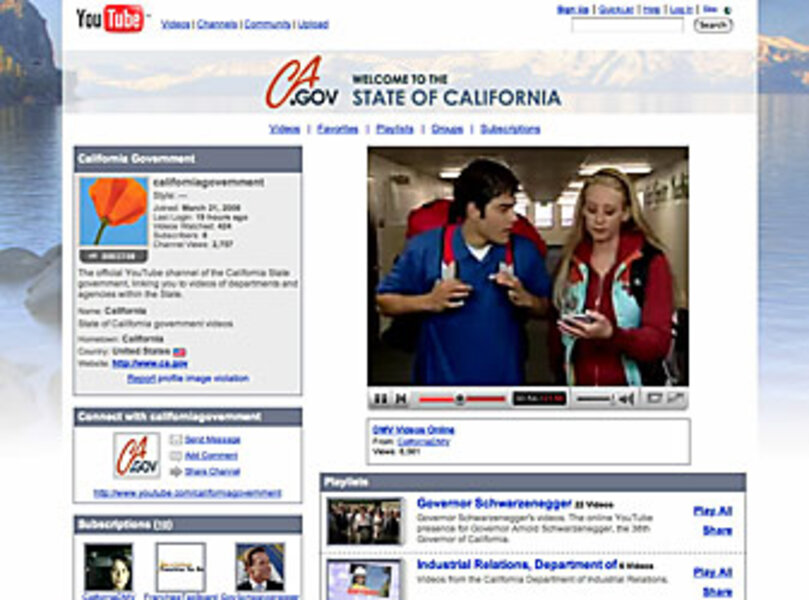To reach youth, California goes YouTube
| Los Angeles
Question: What do you get when you cross the stuffy subject of America's largest state government with the audiovisual possibilities of the digisphere? Answer: http://www.YouTube.com/Californiagovernment.
Launched this month, California's official video channel aims to further Gov. Arnold Schwarzenegger's mission to make government more accessible to the average person through technology – and hopefully some creativity.
The state follows Virginia and a handful of government agencies into the fast-paced, visually stylized universe of YouTube, the popular website where users post and watch short video clips.
"We are looking at the wave of the future, a turnover in how governments are going after engaged citizens," says Barbara O'Connor, professor of communications and government at California State University, Sacramento. "The boomers are moving on and states want to master a medium that younger, tech-savvy folks regularly use."
In California's case, the subjects are drier than most YouTube videos – tax filing, DMV procedures, industrial relations, transportation highway updates, and even replays of the governor's past press conferences. But many of the video clips try hard to engage and entertain. They're certainly more easily digested than the oatmeal-drab, text-heavy offerings on standard government websites.
Reaching young people
"I usually don't even do my taxes, but this 'Ready Return' is pretty cool," says a 20-year-old male in a California Franchise Tax Board video, in which he stands against a white wall, as jazz piano plays in the background. "Want some good advice from a really legit homey? Use 'Ready Return,' dog."
Another in the series of tax videos features state controller John Chiang with the foil of "Employee Andrew." The two banter like PC and MAC actors in the popular TV ad for Apple Computers.
As in the rest of the YouTube universe, some videos are more sophisticated than others. They have already attracted the attention of leading political organizations and video mavens.
"It's fantastic what they are doing," says Betsy Rosenfeld, director of "Video Voter" and "Voter Minutes" for the Center for Governmental Studies. She sees the new sites as a continuation of the trend of simultaneously entertaining and educating that began with Bill Maher's show "Politically Incorrect," and continued with Jon Stewart's "The Daily Show."
"Maher taught people the importance of our political system and how things work without people noticing that was what he was up to," says Ms. Rosenfeld. "That's what these YouTube videos do."
But not all have been impressed by the initiative.
"The state's YouTube videos vary in usefulness," says Jack Pitney a political scientist at Claremont McKenna College. "The public service announcements are slick but unhelpful. Who goes on YouTube to seek propaganda from a state agency? Just because you can go on YouTube, doesn't mean that you should."
For state, an easier option
Government officials say using the free access model of YouTube instead of creating and managing their own website makes greater sense, given the limited resources.
"Commercial and government entities are looking at this more and more as really cool because there is no cost to upload," says Janet Mendoza spokesperson for the California Dept. of Motor Vehicles.
Virginia government's playlists are more extensive but less creative than California's. They include state agency messages; parks, schools, and library announcements; and historical vignettes – often preceded by advertisements and linked to other related sites and blogs. Many are straightforward public service announcements.
Andrew Armani of the California's State and Consumer Services Agency says the idea of launching a state channel on YouTube arose when officials realized that agencies were creating their own video sites, and that it would be less confusing for the public if everything was put on one site. For now, the YouTube channel is an extension to the existing state website.
Various state agencies say they are pleased with the increased response, though no numbers on usage are available yet. As with other YouTube channels, users can leave comments and initiate conversations.
For YouTube, offering up the video platform to state governments and agencies is a continuation of other recent forays into the political sphere. Its voter initiative YouChoose '08, for example, allows presidential candidates to post videos on their own channels.
Describing the Website as "the world's largest town hall," a company spokesperson, in an e-mail response, said that YouTube believes in the "value of online video as a platform for connecting political leaders and their constituents. Our YouChoose '08 platform ... opens the political dialogue to everyday Americans and government officials alike."





